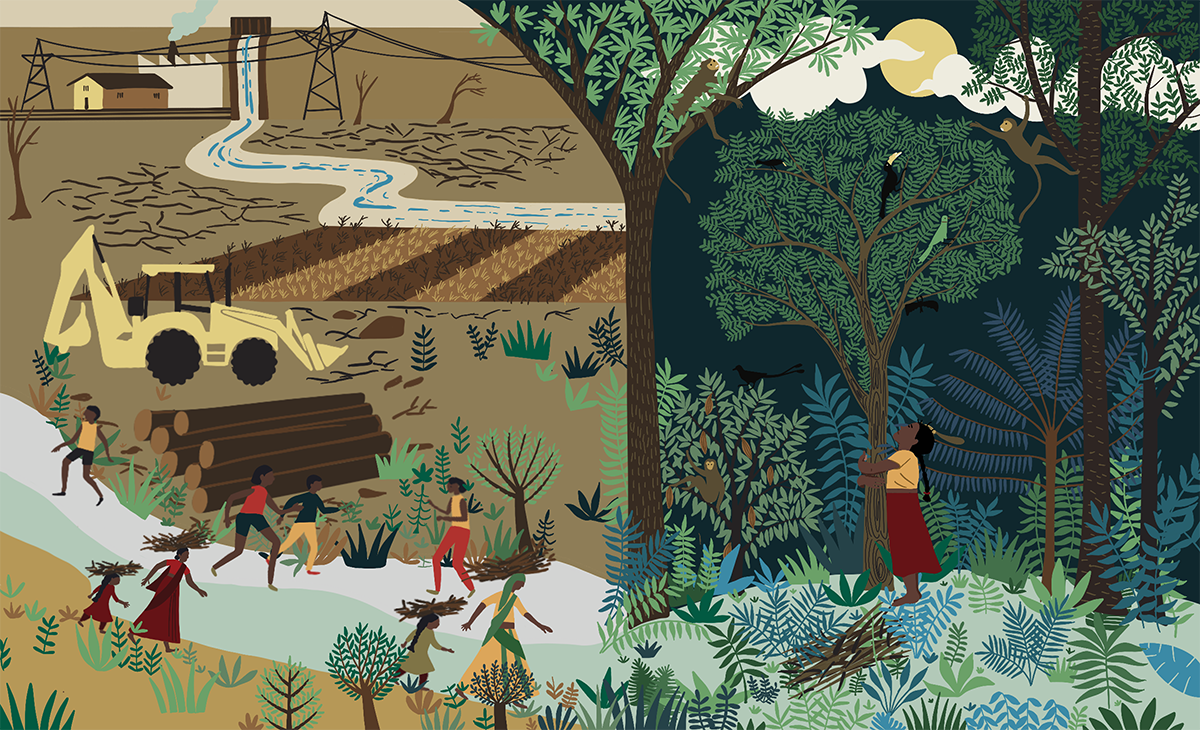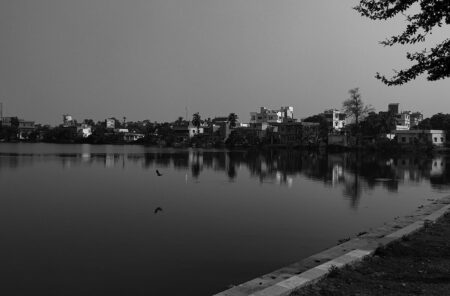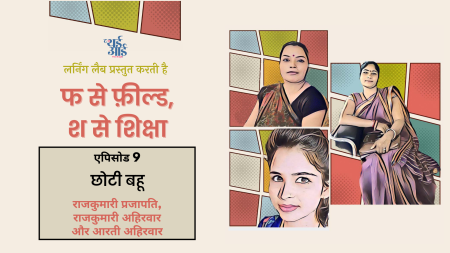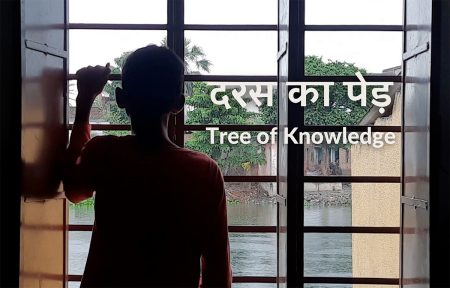The Mind Map accompanies our Travel Log. The Third Eye’s Travel Programme that mentored 13 writers and image-makers from across India’s bylanes to reimagine the idea of the city through a feminist lens. An artist worked with a Fellow to visualise their town, village or city, a ‘map’ of the spaces they actually live in; a combination of their mental, emotional, spiritual and physical landscapes to help us imagine the ‘city’ subjectively.
Prakash Ransing is a surveyor based in Toranmal in Maharashtra.
Prakash’s Mind Map is imagined by The Big Fat Bao (@thebigfatbao), an artist from Maharashtra based in Germany, whose work engages with anti-caste and feminist politics, food history of Dalit communities, and Bahujan art, history and culture.
Presenting our second Mind Map of the series, where Prakash and Bao try to make sense of a warped world that looks at the Adivasi as an outsider.
What did you think of Prakash’s letters when you first read them?
Bao: When Prakash and I met for the first time, he told me the story, the context behind his letters. The letters are so moving and beautiful – there’s a section in the second letter about how indigenous and tribal communities’ understanding of nation and land ownership is very different from that of mainlanders. This section has stuck with me and I’ve raved about Prakash’s writing to my mother and close friends already. In fact, there was a period during the second wave of the pandemic when I was facing a major creative block. I’d pick up Prakash’s letters and read them to feel and find a sense of purpose. I have been eagerly waiting for quite some time for them to be published.
The little girl’s journey in his letter reminded me of the time I was working with the Wildlife Conservation Trust (WCT) in Nagpur, Chandrapur, Andhari, etc., and we would see families walking outside the forest in the November winter air, along with their children. Back then, we had gone there from a conservationist perspective.
I feel there is a fair amount of debate on what an outsider’s relationship with the forest is but Prakash’s letters made me think about what kind of relationship indigenous communities share with the forests they live in.
Whenever someone tells me they think I am a very political person, I feel it’s not entirely true because of how detached our politics is from jal, jungle, zameen. Our concepts of nationhood and nationalism are often restricted to a theoretical framework defined by homogeneous and narrow ideas of borders, cultures and society. Whereas indigenous communities’ politics, their ideology – all of it is very deeply and meaningfully intertwined with their land, their water and their forest. Prakash’s letters are a firm reminder of that.
Prakash: I didn’t quite understand what a mind map exactly is or what it is supposed to do – so the TTE team and Bao helped me understand that. Bao and I had two to three rounds of conversations where I’d look at a draft of her drawing and make suggestions based on my experiences. For example, I asked her to tweak the clothes of the women a little as they were not exactly the ones women wear here. Bao is a Marathi speaker like me, so it was endearing and comfortable communicating with them.
Prakash, why did you choose the format of a letter?
Prakash: I showed The Third Eye team a letter that I had written to my friend about my work and the situation here in Nandurbar. They really liked it and encouraged me to use the [same] style.
Letter-writing is a very personal process and it helps me express myself and my politics better, unlike academic writing. It holds space for one to express their politics from the heart, and strike an emotional chord with the reader.
I also want to use letters as a medium to reach out to my friends, activists and politicians – outside of India, and tell them about our lives here and how governments’ developmental projects are causing such widespread environmental and human destruction.
These are friends who work in showrooms and big companies, who take an interest in politics but are clueless about what goes on inside the jungles of India, which are home to so many Adivasis. I hope my letters will give people a glimpse of the onslaught Adivasis, plants, animals and all the inhabitants of the jungle face at the hands of the state. I also hope the language of the letters captures the deeply personal and selfless relationship indigenous people share with the forest.
Bao, could you talk a little about the process of making the mind map?
Bao: I already had some idea as to what the Central Indian landscape is like. In September-October, it is quite green and lush, and slowly as winter sets in, one can see the leaves falling, and there’s a change of smell in the air. In summer months, the climate gets hotter and in addition to the heat, one also feels the coal dust from the Chandrapur mines enveloping the air. It sometimes settles into the nose, and it is pretty much all you notice while breathing. These details are based on my own experiences and memories of living in the Central Indian landscape.
Prakash’s letters have two perspectives going – an insider’s and an outsider’s. The outsider’s perspective only generates pity for those in the jungle; it is an unfortunate reality how the ‘outside’ or the ‘outsider’ is so disconnected from the earth, from the forest, from the land they inhabit (and encroach upon).
On the other hand, I wanted to depict the ‘inside’ or the ‘insider’ as the girl in the forest. I wanted to depict her as thinking about her future, her relationship with this land, how it may change in the future, what she and her family will do if they were to get ‘out’.
So thinking about and drawing these contrasts was the initial process of the mind map.
If you look at the figures that I have drawn on the ‘outside’, they are not very well defined or detailed: crude if I might say; just the way we are outsiders, with no knowledge or understanding of the earth, the forest or the politics surrounding it. The forest is seen as green, very lush because every leaf matters, every detail matters in a forest. The forest dwellers are the protectors of the forest; they don’t consider themselves separate from the forest – the tree is an individual for them just like any other human.
The figure of the girl hugging the tree is very reminiscent of imagery from various environmental movements. Can you talk a little about that?
Bao: It is, to some extent, but it is not just that.
For an upper caste gaze, the girl hugging the tree may just be a symbol of something like the Chipko Movement but it goes much deeper than that.
From a design perspective, it is more about space and how that girl navigates space and different elements inside the forest. When indigenous communities navigate and walk through a forest, they are not fearful of the tiger; they worship it. They know that if the tiger dies, it will affect their entire food cycle. They know that if the river dries up, the tiger will come closer. If the river exists, the deer will go there, and the tiger will go there instead of attacking their cattle. So, it is not just a girl hugging a tree for the sake of it; the people share a close-knit relationship with the trees, animals and bushes. They hug them and talk to them and often say, “How are you? Look at you, you’ve grown so big! I hope you’re getting enough water?” (तू कशी आहेस? बघ, तू कित्ती मोठी झाली! तुला नीट पाणी मिळतं का ग?)
I also did not want the illustration to have any suggestion of a saviour complex and wanted to do away with this idea of ‘us’ educating ‘them’.
The girl who is hugging the tree – the idea of education is very different to her: she doesn’t need to be taught that she has to hug a tree to conserve it. She knows the ecosystem of the forest better than any of us do.
Prakash: I concur with Bao. Conservationists from outside come and talk about ‘teaching’ forest dwellers and indigenous communities, doing charity, etc., but they don’t talk about rights. Who will talk about rights? The Right to Land? The Right to Forests? The Right to Food, Water and Shelter?
Today’s environmentalism has mostly become about outsiders coming and capitalising on Adivasi issues to further their own research and careers. Till the time no one talks about ‘rights’, how will the Adivasi community benefit from any of this environmentalism?
Leaders of environmental movements should emerge from the Adivasi community itself.
This image of the girl, as Bao said, is a very accurate depiction of the kind of close relationship they share with all the animals and plants around them. They don’t fear the tiger; they worship it but no one will tell you that and instead false narratives about Adivasis being responsible for forest destruction spread – how is that even possible when they live in such a harmonious, close relationship with the forest? Developmental projects are the problem, not Adivasis.
What were some of the challenges you encountered creating the mind map?
Bao: The major challenge and constraint was to depict the jungle, the forest, as accurately as I could. The jungle is continuously changing and I wanted to do justice to Prakash’s visualisation. So, accuracy was the biggest challenge. But it was quite different from other art projects because Prakash has lived in the forest and knew exactly what he wanted me to create, unlike a lot of people who have no idea what a forest is like and want me to create a very happy and lively image.
Forests are not always happy, they are as real as they can get. The only difference is that cities are dystopian – they are racist and casteist, unlike a forest where there is space for every species to exist and grow.
How do the indigenous communities you work with channelise their anger and confront the development project of the state?
Prakash: It’s quite tricky actually.
There is still an urgent need to come together and develop this understanding that land, water, forest – all of this has not been ‘given’ to us by the state, but it is, in fact, a fundamental right.
A lot of people from the community are still accustomed to the colonial ways of confronting or looking at people in power – there is a certain unintentional reverence too in the ways that they address the police or administration as ‘saheb’. The people who have managed to get out and get educated have a lot of anger because they recognise the ways in which they are being exploited but there still needs to be more sustained organising and mobilising to channel this anger collectively.
Outsiders leading environmental movements do not have a connection with the forests; they are conservationists because they realise what consequences they will face when climate change occurs and sea levels rise. They lead climate justice movements to save themselves. However, indigenous communities have never had to learn to ‘protest’ against climate injustice because by virtue of their home being the forest, they have a visceral, emotional, fierce, protective connection with it. Adivasis are the inhabitants of forests and if you don’t give them the rights they are entitled to, no environmental conservation can happen.
Is there something that you consciously incorporate in your artwork – whether in terms of form or elements that break through the green-capitalism discourse of conservation that we are embedded in – the much-critiqued approach that says we can use the levers of the market to fix the environment?
Bao: Yes, so one is that I always try to depict a woman or a girl with whatever element of nature I draw – I believe that women and the marginalised genders play a huge role and I want to consciously depict them as people with agency, people with solutions because we need to listen to them more, we need to read and build on their histories of struggle.
Secondly, and this is something I and Prakash both need to work on, is how do we imagine an indigenous person, an Adivasi person not just as a citizen of a nation but a global citizen?





